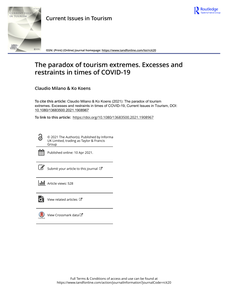This paper seeks to highlight underlying issues of the tourism system that have led to tourism extremes of too much or too little tourism. Five phases are recognized that reflect different ways of dealing with too much tourism over time, after which the impact of a sudden lack of tourism is investigated in light of future renewal processes. This discussion highlights the remarkable capacity of the tourism industry to adjust to rapidly changing circumstances and crises, even when these cause anguish to individuals and within societies at large. The paper thus seeks to contextualize the current discussions regarding the transformation of tourism post COVID-19. It highlights the complexity of changing a tourism that multiple stakeholders depend on or have grown accustomed to. To come to a more balanced tourism, it is necessary to not only come up with alternative visions and strategies, but also to engage with the political economy nature of tourism development. A future research agenda should therefore also discuss facets of entangled power, social exclusion, inequalities and class differences to come to new reference points of what actually constitutes a more inclusive tourism success.
MULTIFILE

Relatively little empirical research has been conducted on impacts of volunteer tourism in local communities. This paper therefore focuses on the local consequences of volunteer tourism for two projects in Tamale, Ghana: Zion Primary School and Tamale Children's Home. A practice approach provides a useful theoretical framework to investigate how volunteers and local actors interact in these projects. In a practice approach, interactions become central to the analysis, highlighting the ways in which volunteers, local people and the local context mutually influence one another. Observations and interviews with volunteers and local actors were used to identify positive and negative consequences of their interactions, which are strongly interlinked and depend on routines, backgrounds and positions of the actors, and contextual conditions. The consequences of volunteer practices are also linked to other current and future practices. A practice approach provides insights into complex situations and may be more suited to analysing the impacts of volunteer tourism than a traditional mono-disciplinary focus.
LINK
The following paper explores socio-cultural impacts of large-scale cruise liner tourism on the traditional bazaar (souq) in the district of Mutrah. The souq is located opposite the port in the Omani capital Muscat. Large-scale cruise tourism in Muscat started only in 2004 and has increased in scale and numbers in the past years. 24 cruise vessels with around 7600 passengers arrived in Muscat in 2005. Seven years later 135 cruise liners carrying 257,000 tourists docked in Muscat. Due to this dramatic rise of international cruise ships, the socio-cultural impacts have increased for local residents, shop vendors/owners and tourists alike. To capture those socio-cultural impacts on Souq Mutrah, a survey of cruise tourists was conducted by a questionnaire. In addition, the researcher used participatory observation, counting, and in-depth interviews with different stakeholders of the local community and different types of tourists during the cruise seasons 2012/13 and 2013/14. Moreover, content analysis of statistics and local media publications were used. Results indicate that the souq has become "the core of a tourist bubble", where crowding is a major problem and local residents avoid the place. The social carrying capacity of the souq has been reached. Omani vendors are leaving their businesses and renting their shops out to expatriates. Since contemporary cruise tourists are low spenders, expatriate shop sellers have become more aggressive.
DOCUMENT
Inzicht verkrijgen in het belang van verblijfs-en dagtoerisme voor de gemeenten Alphen Chaam en Gilze Rijen. Het onderzoek kijkt primair naar de economische impacts van toerisme in de regio dmv Input-Output model, maar sociale en ecologische aspecten worden tevens meegenomen.Client: Toerisme de Baronie
In this project we utilize the conversational model of delivering destination information as an experimental intervention to provide tips to a sub-group of visitor participants in one specific destination, Overijssel. By contrasting the experience of this group to a randomly assigned control group will be able to test the effectiveness of hyper-personalized information. Furthermore, we will investigate the effectiveness of integrating, in the tips provided, the policy of the DMO to direct visitors to certain places while reducing the pressure on others. For this variable as well––policy-driven vs. demand-driven information sources––random assignment to test and control groups will allow us to draw conclusions about causes of differences in tourist behavior and experience.The main question is: Does the conversational information model, as exemplified by Travel with Zoey, create the possibility to direct people to the places destination managers would like them to go, while assuring they benefit equally––or even more–from their travel experience? Partners: NBTC, Marketing Oost, Travel With Zoey.
The FlexEd project is intended as an extension of the Leisure Choices and Wellbeing (LCW) project which is now very concretely and definitively planned to run from November 2024 through January 2026. The LCW project is facilitated by the Academy for Leisure. The Leisure Choices and Wellbeing, The LCW project will use a weekly longitudinal questionnaire of 200 individuals (final sample after attrition) over 40 weeks to measure leisure activity planning, participation, and wellbeing. The three main aims of the project are to uncover the roles of 1) social interaction during leisure, 2) novelty/change in routine during leisure, and 3) leisure travel duration and frequency, in explaining individuals’ and families’ wellbeing. By measuring changes in these leisure activities week to week, it will be possible to uncover how development in leisure choices accrues to improved well-being over time. Societal issueFlexibility in the education calendar for better vacation impacts in society.Collaborative partnersCELTH, ANVR.